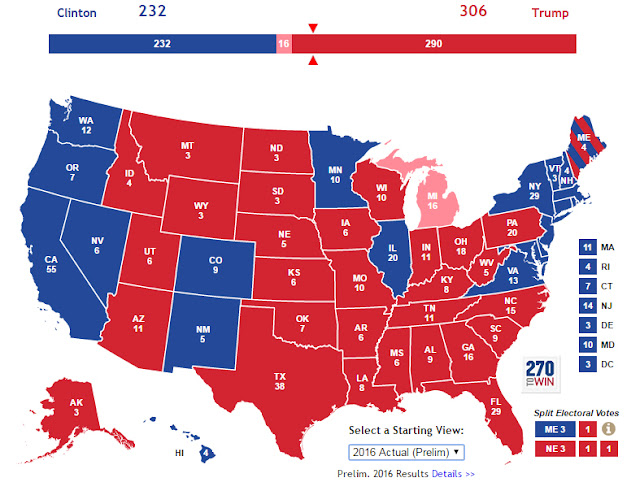Back to the Future: The Electoral College Strikes Again
by Shawn Healy, PhD, Civic Learning Scholar
Monday’s post analyzed one of the greatest upsets in presidential election history and parsed the polls that predicted the opposite. Today we’d like to revisit the venerable Electoral College, back in the news after a sixteen-year hiatus.
The vote count continues, but as of this writing, Hillary Clinton claims a popular vote lead approaching 800,000 votes nationally, besting Donald Trump 47.8% to 47.2%. Trump, of course, leads in the only place that matters, the Electoral College, 290 to 232, with Michigan’s 18 electoral votes still outstanding but likely to be added to his column in the coming days.
 |
| 2016 Election Results Courtesy of 270toWin.com |
This dichotomy has occurred four times in our nation’s history, and twice in the last five presidential elections.
Conventional wisdom heading into November 8th was that Democrats had an Electoral College firewall that included the two coasts, selected states in the Mountain West, and most of the Rust Belt. This would protect against potential losses in Iowa, Ohio, North Carolina, and Florida. The firewall cracked in the industrial Midwest, propelling Trump past the 270 electoral votes needed to win.
Beneath the surface, Clinton ran up the score in blue states like California and Illinois, and closed the gap from 2012 and earlier in red states with large Latino populations like Texas and Arizona. However, at the end of the day, they remained part of the vast inland red sea.
The Democratic vote remains heavily concentrated in urban areas. This is a numerical advantage from the perspective that more than 62% of the population resides here, but its concentration in California and along the Eastern Seaboard makes controlling Congress, and prevailing in the Electoral College, increasingly difficult as the Republican vote is more geographically dispersed.
Parties are evolving coalitions, and every victory and defeat spurs a reaction. Democrats will likely lick their wounds and strategize on how they might win back the white working class vote. And Republicans would be wise to consider how they can better appeal to Millennials, communities of color, and college-educated whites as a demographic death spiral looms.
Split decisions like 2016 inevitably lend themselves to discussions of abolishing the Electoral College. This would require a constitutional amendment, and retiring Senator Barbara Boxer (D-CA) has filed such legislation. Even without strong Republican headwinds, the prospects of its success are arduous at best.
A couple of more modest statutory reforms may also surface. They include states adopting the Maine and Nebraska approach of awarding electoral votes by congressional district, or the campaign for the National Popular Vote, where states agree to deliver their electoral votes to the popular vote winner once a coalition of states holding 270 or more votes emerges. Illinois is among eleven states that have already adopted this legislation, but prospects of further gains are dim in the short-term given unified Republican control of 33 of 50 state legislatures, and partial control in six others.




Comments
Post a Comment